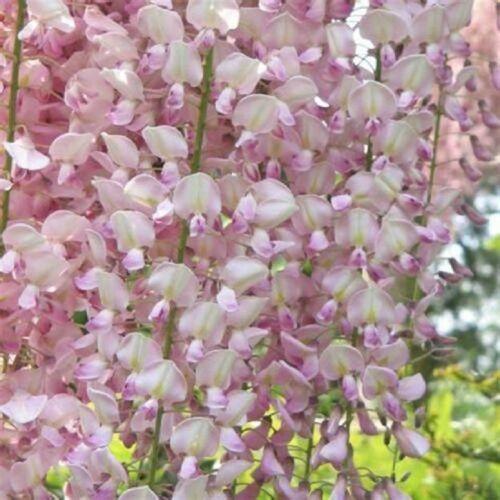Seed World
5 Pink Chinese Wisteria Seeds
5 Pink Chinese Wisteria Seeds
Couldn't load pickup availability
Pink Chinese Wisteria Seeds Vine Climbing Flower Perennial Rare Tropical
Wisteria is a fast-growing, deciduous vine which, according to the National Gardening Association, can grow 10 feet or more in one year. They are noted for their fragrant flower, which resembles clusters of grapes. Wisteria is very versatile and can be grown as shrubs, vines, or even trees. Wisteria can grow to achieve heights of 20 to 30 feet with flowers widely in color.
Germination
Put your wisteria seeds in a bowl of hot water for 10 to 12 hours. Remove the seeds from the water and with a nail file, gently nick, or file off, a portion of the seed hull.
Fill up your planting cells with a seed starting mix. Saturate the soil, allowing it to drain off. Place two wisteria seeds in each planting receptacle and cover with no more than 1/4 inch of the seed sprouting mix.
Place your wisteria seeds in a room in your house that has ample light and warmth. Inspect the seeds each day. According to New Mexico State University's Extension Outreach Program, keep your wisteria seeds well moistened until they sprout. Germination time for wisteria seeds is sporadic; it can require 10 to 30 days before you will see any sprouts.
Once your wisteria seeds have sprouted and are 4 to 5 inches tall, with at least two sets of leaves, decide if you want to plant them directly into the ground, or in other growing containers, such as barrels.
Transplanting Wisteria
Wisteria is not picky about soil, but choose a sun-filled location in your garden to plant your wisteria. Or if you're going to plant them into larger pots, or barrels, ensure that they are in a location that's conducive to growing a wisteria, and which can provide ample support for your wisteria as it grows.Turn over the soil with your shovel removing sticks, rocks, or weeds. The Ohio State University Extension Horticulture and Crop Science Department suggest working in either peat moss, compost, or well-rotted manure into the soil where you're going to plant your wisteria. If you're transplanting your wisteria into pots, or barrels, replace the soil with an average potting mix.
Dig holes that are only as deep as the planting receptacle, but are 2 to 3 times wider than the planting receptacle. And if you're planting multiple wisteria plants in the ground, each hole should be spaced 10 to 15 feet apart. Fill the hole halfway with water; allow it to drain.
Remove a wisteria from a planting cell by pushing up from the bottom of the root. Once the plant is free, carefully extract it from the receptacle. Place the wisteria plant in the hole, making sure the level of the surrounding soil is level with the base of the wisteria stem. Fill the hole, tapping down on the dirt as you go, to remove any air pockets. Carefully water each wisteria plant, make sure not to drench the stems or leaves.
Bear in mind it can be many years before your wisteria blossoms. To care for and maintain your wisteria, the National Gardening Association recommends the following: placing a layer of compost under each plant every spring, followed by a 2-inch layer of mulch; water your wisteria during the summer months if rainfall is less than 1 inch per week; and encourage plentiful blooms, after blossoming, by pruning back side shoots that sprout off main stems.
Share




